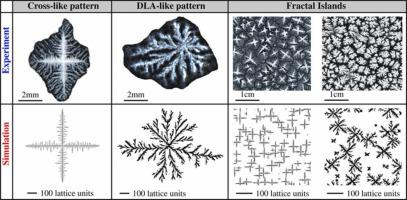Colloids and Surfaces A: Physicochemical and Engineering Aspects ( IF 4.9 ) Pub Date : 2021-12-17 , DOI: 10.1016/j.colsurfa.2021.128094 Alireza Alipour 1 , Majid Abedi 2 , Mehdi Habibi 3

|
研究矿物盐在复杂胶体盐基质薄膜干燥过程中的结晶动力学是一个具有相当研究兴趣的课题,因为它与材料的结构、性质直接相关,并且对于控制结晶和胶体产品设计至关重要。在本文中,使用实验和数值方法系统地研究了由结晶机制引起的宏观结构的形状和尺寸分布。在实验中,氯化钠在淀粉或黄原胶溶液中的结晶被认为是一个模型系统。发现诸如介质的蒸发速率和局部粘度等量化参数主要控制分枝状树枝状图案的成核和传播,导致几类分形聚集体,如河流纹、十字纹、指状结构等。图案的分形维数与盐浓度无关,但随增稠剂的初始浓度而变化。通过基于扩散限制聚集 (DLA) 和沉积、扩散和聚集 (DDA) 算法的两个修改模型,对蒸发速率和介质粘度对图案形成的结晶动力学的影响进行了数值模拟,这使我们能够成功地重现实验结果。我们的实验结果和数值方法为控制复杂凝胶基质中形成的晶体和图案的大小和形状开辟了道路。图案的分形维数与盐浓度无关,但随增稠剂的初始浓度而变化。通过基于扩散限制聚集 (DLA) 和沉积、扩散和聚集 (DDA) 算法的两个修改模型,对蒸发速率和介质粘度对图案形成的结晶动力学的影响进行了数值模拟,这使我们能够成功地重现实验结果。我们的实验结果和数值方法为控制复杂凝胶基质中形成的晶体和图案的大小和形状开辟了道路。图案的分形维数与盐浓度无关,但随增稠剂的初始浓度而变化。通过基于扩散限制聚集 (DLA) 和沉积、扩散和聚集 (DDA) 算法的两个修改模型,对蒸发速率和介质粘度对图案形成的结晶动力学的影响进行了数值模拟,这使我们能够成功地重现实验结果。我们的实验结果和数值方法为控制复杂凝胶基质中形成的晶体和图案的大小和形状开辟了道路。通过基于扩散限制聚集 (DLA) 和沉积、扩散和聚集 (DDA) 算法的两个修改模型,对蒸发速率和介质粘度对图案形成的结晶动力学的影响进行了数值模拟,这使我们能够成功地重现实验结果。我们的实验结果和数值方法为控制复杂凝胶基质中形成的晶体和图案的大小和形状开辟了道路。通过基于扩散限制聚集 (DLA) 和沉积、扩散和聚集 (DDA) 算法的两个修改模型,对蒸发速率和介质粘度对图案形成的结晶动力学的影响进行了数值模拟,这使我们能够成功地重现实验结果。我们的实验结果和数值方法为控制复杂凝胶基质中形成的晶体和图案的大小和形状开辟了道路。

"点击查看英文标题和摘要"





















































 京公网安备 11010802027423号
京公网安备 11010802027423号